Strategic Management: M&A Concept and Dell-EMC Case Study Analysis
VerifiedAdded on 2021/04/21
|20
|6249
|25
Report
AI Summary
This report delves into the strategic management concept of mergers and acquisitions (M&A), examining its definition, historical evolution through six waves, and the arguments for its creation, including product diversification, financial improvements, and operational efficiency. The report analyzes the M&A process, supported by theories and models. A real-life case study of the Dell-EMC merger is presented to illustrate the practical application of M&A, highlighting its benefits, customer opportunities, and challenges. The report aims to provide a comprehensive understanding of M&A's role in strategic management and its impact on business operations, offering valuable insights for students and professionals alike. The analysis covers the strategic fit of M&A, its implications for various stakeholders, and its contribution to achieving business growth and market competitiveness.
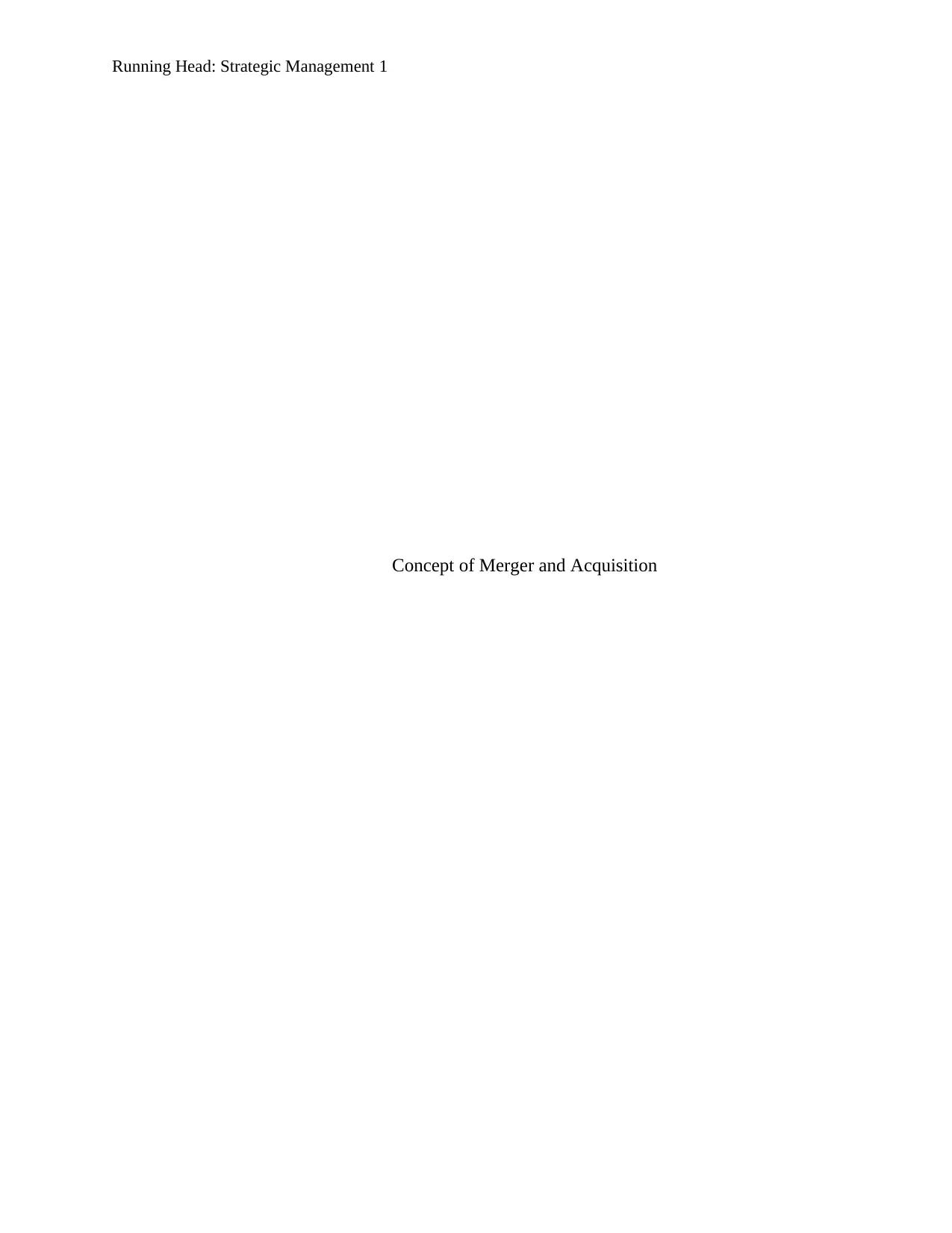
Running Head: Strategic Management 1
Concept of Merger and Acquisition
Concept of Merger and Acquisition
Paraphrase This Document
Need a fresh take? Get an instant paraphrase of this document with our AI Paraphraser
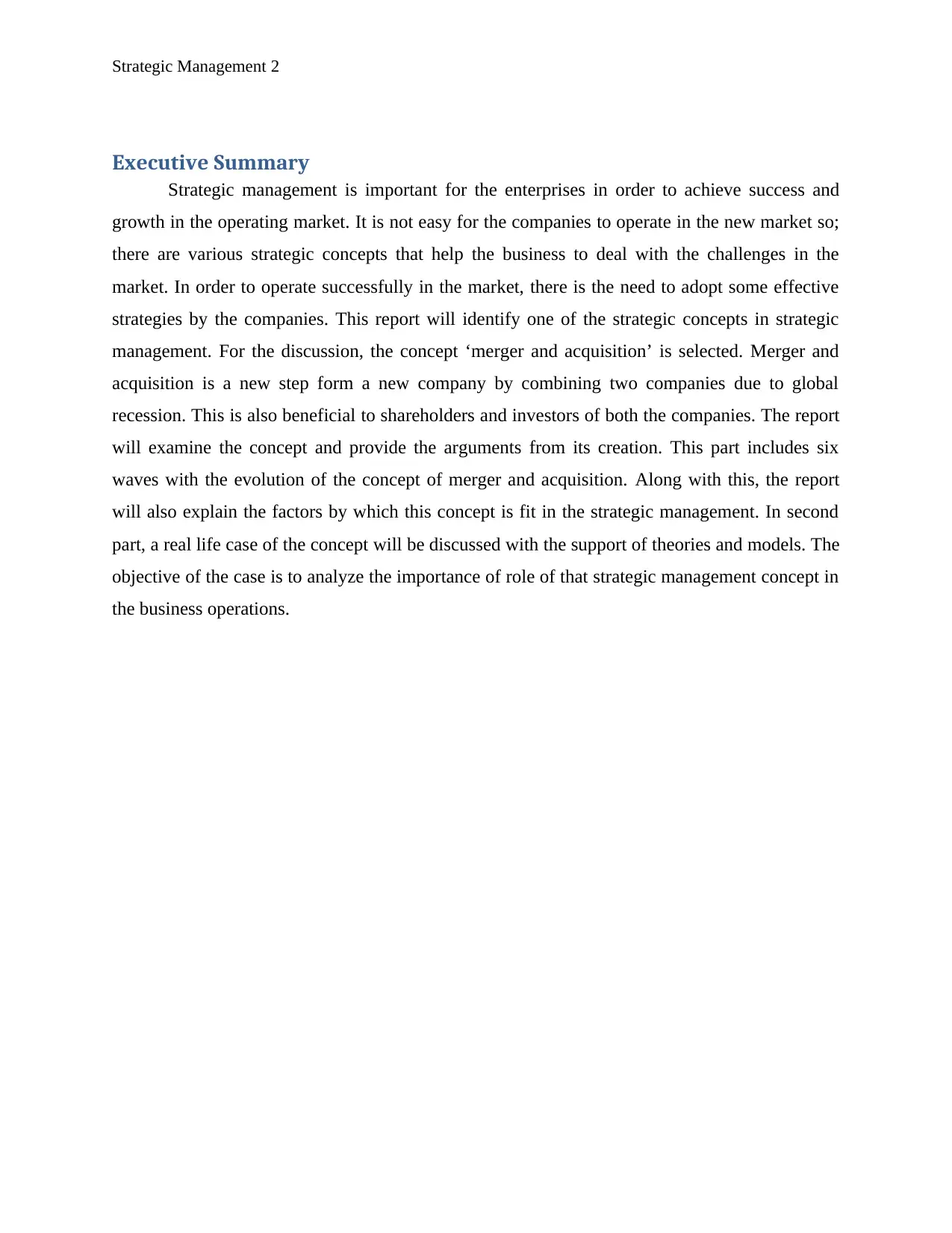
Strategic Management 2
Executive Summary
Strategic management is important for the enterprises in order to achieve success and
growth in the operating market. It is not easy for the companies to operate in the new market so;
there are various strategic concepts that help the business to deal with the challenges in the
market. In order to operate successfully in the market, there is the need to adopt some effective
strategies by the companies. This report will identify one of the strategic concepts in strategic
management. For the discussion, the concept ‘merger and acquisition’ is selected. Merger and
acquisition is a new step form a new company by combining two companies due to global
recession. This is also beneficial to shareholders and investors of both the companies. The report
will examine the concept and provide the arguments from its creation. This part includes six
waves with the evolution of the concept of merger and acquisition. Along with this, the report
will also explain the factors by which this concept is fit in the strategic management. In second
part, a real life case of the concept will be discussed with the support of theories and models. The
objective of the case is to analyze the importance of role of that strategic management concept in
the business operations.
Executive Summary
Strategic management is important for the enterprises in order to achieve success and
growth in the operating market. It is not easy for the companies to operate in the new market so;
there are various strategic concepts that help the business to deal with the challenges in the
market. In order to operate successfully in the market, there is the need to adopt some effective
strategies by the companies. This report will identify one of the strategic concepts in strategic
management. For the discussion, the concept ‘merger and acquisition’ is selected. Merger and
acquisition is a new step form a new company by combining two companies due to global
recession. This is also beneficial to shareholders and investors of both the companies. The report
will examine the concept and provide the arguments from its creation. This part includes six
waves with the evolution of the concept of merger and acquisition. Along with this, the report
will also explain the factors by which this concept is fit in the strategic management. In second
part, a real life case of the concept will be discussed with the support of theories and models. The
objective of the case is to analyze the importance of role of that strategic management concept in
the business operations.
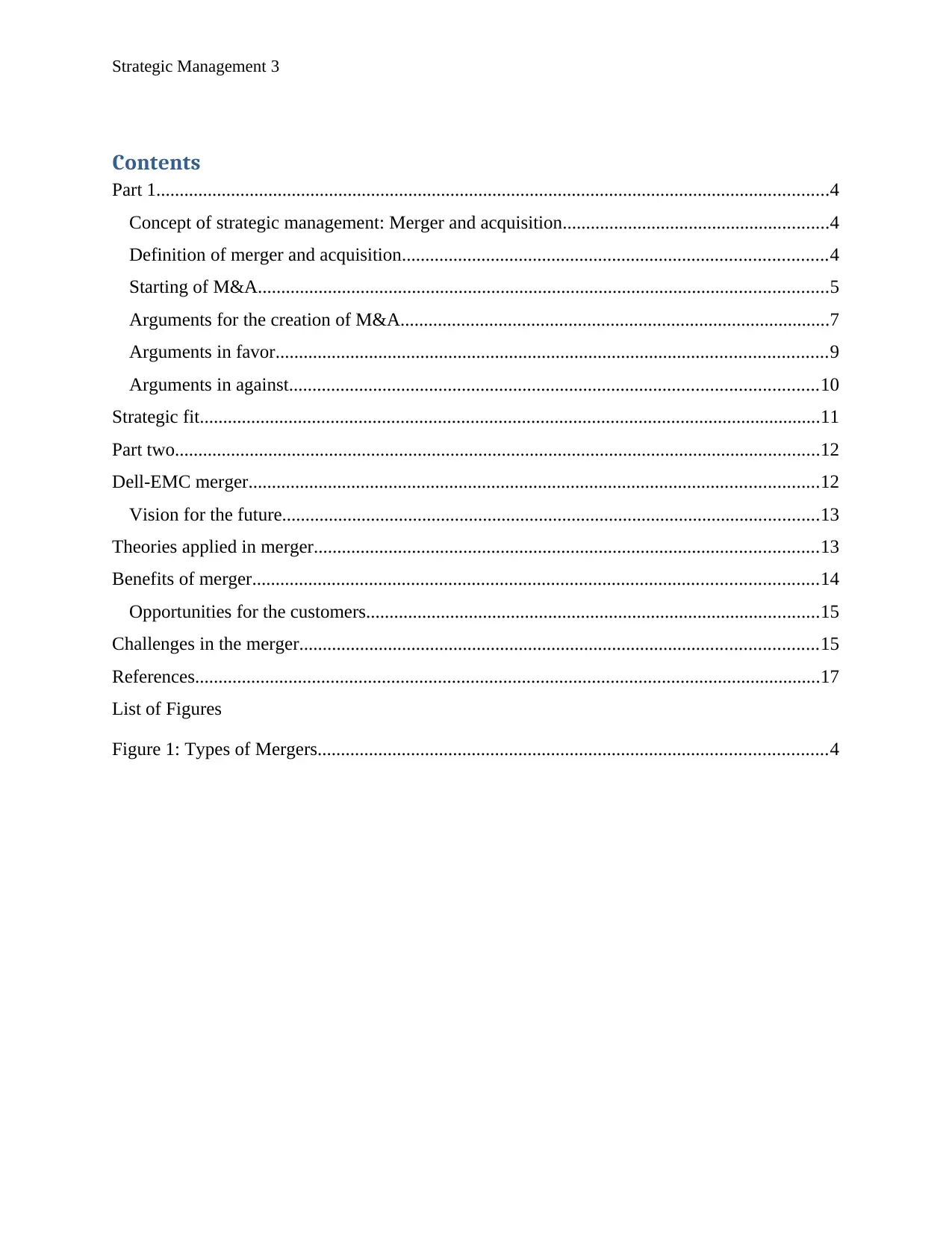
Strategic Management 3
Contents
Part 1................................................................................................................................................4
Concept of strategic management: Merger and acquisition.........................................................4
Definition of merger and acquisition...........................................................................................4
Starting of M&A..........................................................................................................................5
Arguments for the creation of M&A............................................................................................7
Arguments in favor......................................................................................................................9
Arguments in against.................................................................................................................10
Strategic fit.....................................................................................................................................11
Part two..........................................................................................................................................12
Dell-EMC merger..........................................................................................................................12
Vision for the future...................................................................................................................13
Theories applied in merger............................................................................................................13
Benefits of merger.........................................................................................................................14
Opportunities for the customers.................................................................................................15
Challenges in the merger...............................................................................................................15
References......................................................................................................................................17
List of Figures
Figure 1: Types of Mergers.............................................................................................................4
Contents
Part 1................................................................................................................................................4
Concept of strategic management: Merger and acquisition.........................................................4
Definition of merger and acquisition...........................................................................................4
Starting of M&A..........................................................................................................................5
Arguments for the creation of M&A............................................................................................7
Arguments in favor......................................................................................................................9
Arguments in against.................................................................................................................10
Strategic fit.....................................................................................................................................11
Part two..........................................................................................................................................12
Dell-EMC merger..........................................................................................................................12
Vision for the future...................................................................................................................13
Theories applied in merger............................................................................................................13
Benefits of merger.........................................................................................................................14
Opportunities for the customers.................................................................................................15
Challenges in the merger...............................................................................................................15
References......................................................................................................................................17
List of Figures
Figure 1: Types of Mergers.............................................................................................................4
⊘ This is a preview!⊘
Do you want full access?
Subscribe today to unlock all pages.

Trusted by 1+ million students worldwide
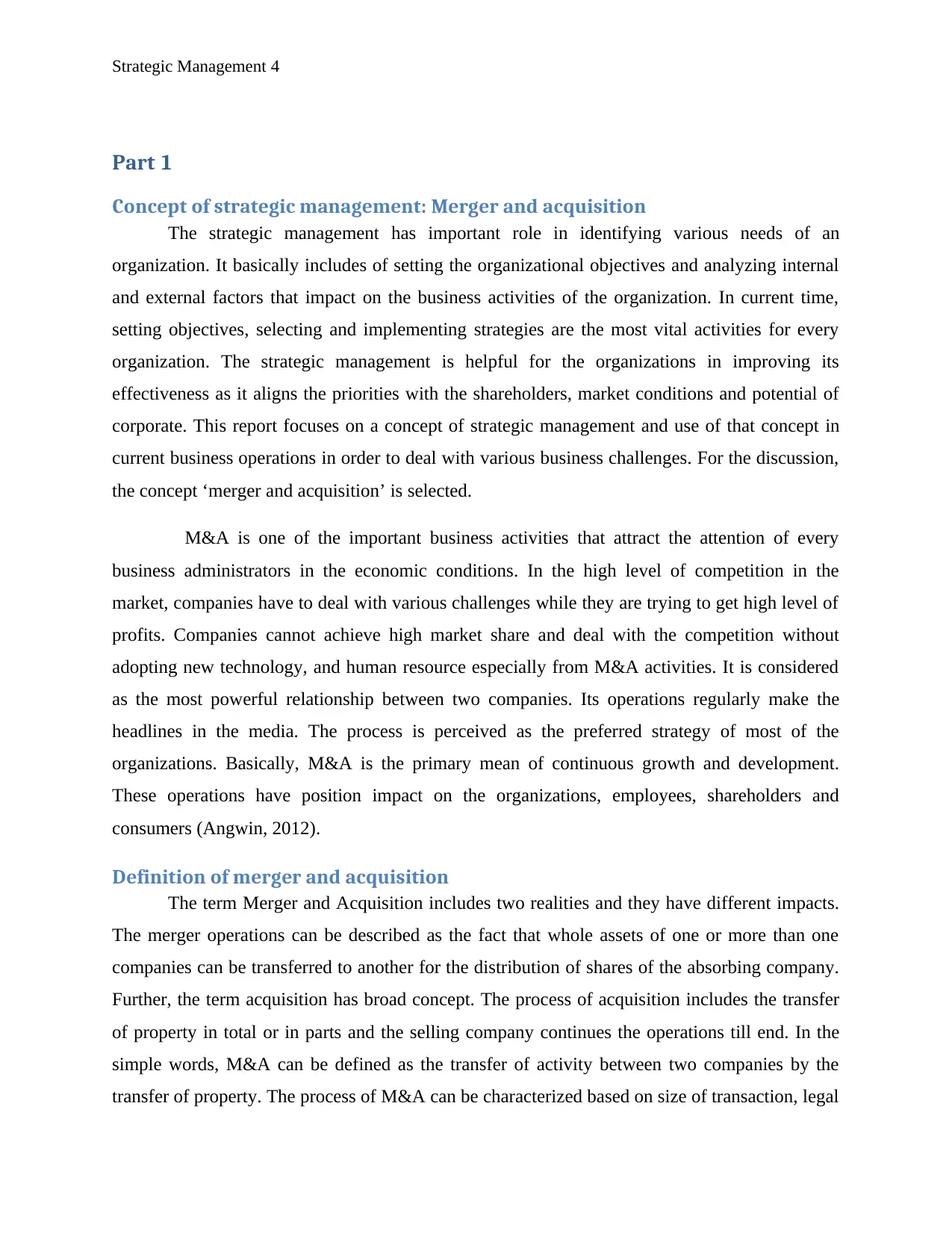
Strategic Management 4
Part 1
Concept of strategic management: Merger and acquisition
The strategic management has important role in identifying various needs of an
organization. It basically includes of setting the organizational objectives and analyzing internal
and external factors that impact on the business activities of the organization. In current time,
setting objectives, selecting and implementing strategies are the most vital activities for every
organization. The strategic management is helpful for the organizations in improving its
effectiveness as it aligns the priorities with the shareholders, market conditions and potential of
corporate. This report focuses on a concept of strategic management and use of that concept in
current business operations in order to deal with various business challenges. For the discussion,
the concept ‘merger and acquisition’ is selected.
M&A is one of the important business activities that attract the attention of every
business administrators in the economic conditions. In the high level of competition in the
market, companies have to deal with various challenges while they are trying to get high level of
profits. Companies cannot achieve high market share and deal with the competition without
adopting new technology, and human resource especially from M&A activities. It is considered
as the most powerful relationship between two companies. Its operations regularly make the
headlines in the media. The process is perceived as the preferred strategy of most of the
organizations. Basically, M&A is the primary mean of continuous growth and development.
These operations have position impact on the organizations, employees, shareholders and
consumers (Angwin, 2012).
Definition of merger and acquisition
The term Merger and Acquisition includes two realities and they have different impacts.
The merger operations can be described as the fact that whole assets of one or more than one
companies can be transferred to another for the distribution of shares of the absorbing company.
Further, the term acquisition has broad concept. The process of acquisition includes the transfer
of property in total or in parts and the selling company continues the operations till end. In the
simple words, M&A can be defined as the transfer of activity between two companies by the
transfer of property. The process of M&A can be characterized based on size of transaction, legal
Part 1
Concept of strategic management: Merger and acquisition
The strategic management has important role in identifying various needs of an
organization. It basically includes of setting the organizational objectives and analyzing internal
and external factors that impact on the business activities of the organization. In current time,
setting objectives, selecting and implementing strategies are the most vital activities for every
organization. The strategic management is helpful for the organizations in improving its
effectiveness as it aligns the priorities with the shareholders, market conditions and potential of
corporate. This report focuses on a concept of strategic management and use of that concept in
current business operations in order to deal with various business challenges. For the discussion,
the concept ‘merger and acquisition’ is selected.
M&A is one of the important business activities that attract the attention of every
business administrators in the economic conditions. In the high level of competition in the
market, companies have to deal with various challenges while they are trying to get high level of
profits. Companies cannot achieve high market share and deal with the competition without
adopting new technology, and human resource especially from M&A activities. It is considered
as the most powerful relationship between two companies. Its operations regularly make the
headlines in the media. The process is perceived as the preferred strategy of most of the
organizations. Basically, M&A is the primary mean of continuous growth and development.
These operations have position impact on the organizations, employees, shareholders and
consumers (Angwin, 2012).
Definition of merger and acquisition
The term Merger and Acquisition includes two realities and they have different impacts.
The merger operations can be described as the fact that whole assets of one or more than one
companies can be transferred to another for the distribution of shares of the absorbing company.
Further, the term acquisition has broad concept. The process of acquisition includes the transfer
of property in total or in parts and the selling company continues the operations till end. In the
simple words, M&A can be defined as the transfer of activity between two companies by the
transfer of property. The process of M&A can be characterized based on size of transaction, legal
Paraphrase This Document
Need a fresh take? Get an instant paraphrase of this document with our AI Paraphraser
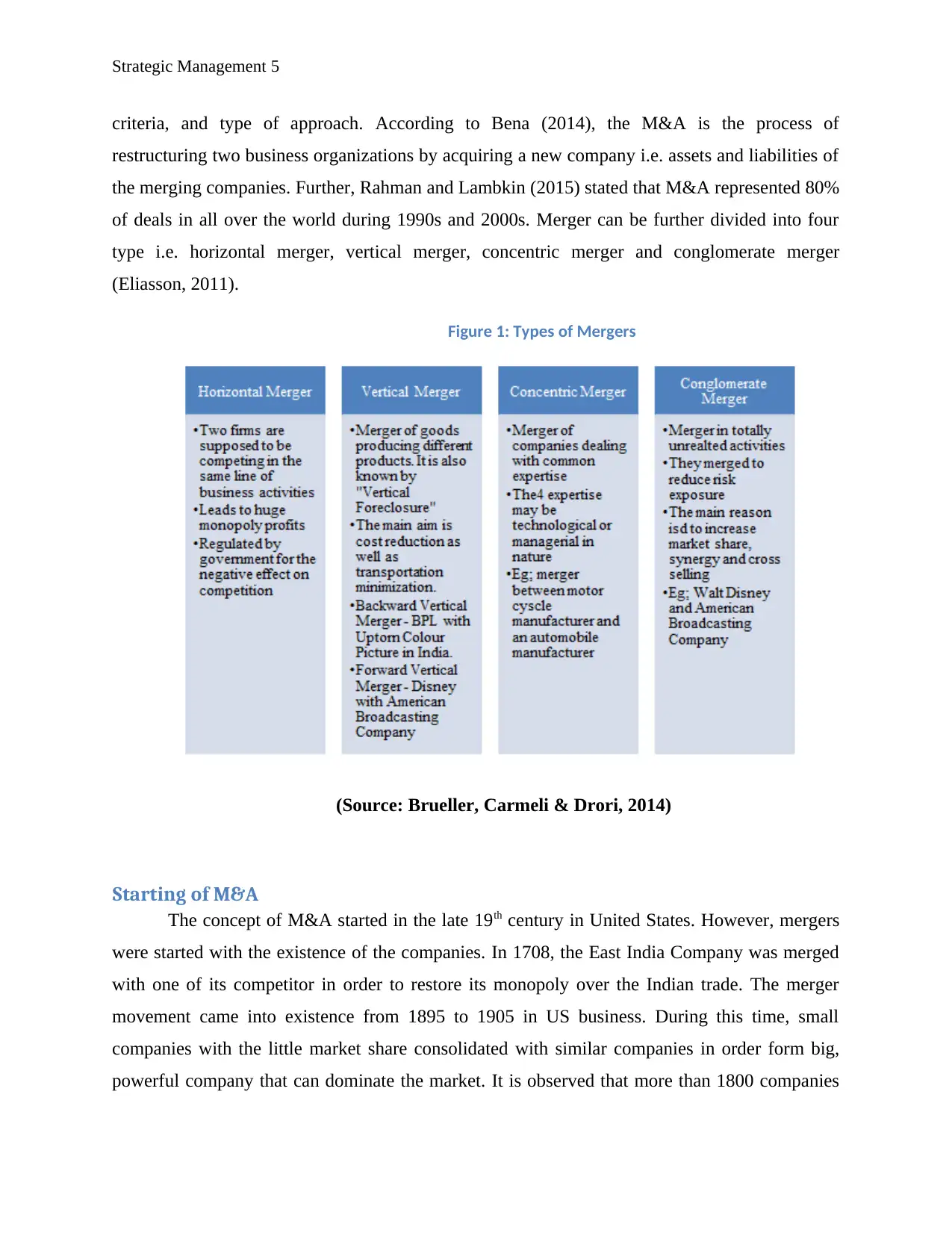
Strategic Management 5
criteria, and type of approach. According to Bena (2014), the M&A is the process of
restructuring two business organizations by acquiring a new company i.e. assets and liabilities of
the merging companies. Further, Rahman and Lambkin (2015) stated that M&A represented 80%
of deals in all over the world during 1990s and 2000s. Merger can be further divided into four
type i.e. horizontal merger, vertical merger, concentric merger and conglomerate merger
(Eliasson, 2011).
Figure 1: Types of Mergers
(Source: Brueller, Carmeli & Drori, 2014)
Starting of M&A
The concept of M&A started in the late 19th century in United States. However, mergers
were started with the existence of the companies. In 1708, the East India Company was merged
with one of its competitor in order to restore its monopoly over the Indian trade. The merger
movement came into existence from 1895 to 1905 in US business. During this time, small
companies with the little market share consolidated with similar companies in order form big,
powerful company that can dominate the market. It is observed that more than 1800 companies
criteria, and type of approach. According to Bena (2014), the M&A is the process of
restructuring two business organizations by acquiring a new company i.e. assets and liabilities of
the merging companies. Further, Rahman and Lambkin (2015) stated that M&A represented 80%
of deals in all over the world during 1990s and 2000s. Merger can be further divided into four
type i.e. horizontal merger, vertical merger, concentric merger and conglomerate merger
(Eliasson, 2011).
Figure 1: Types of Mergers
(Source: Brueller, Carmeli & Drori, 2014)
Starting of M&A
The concept of M&A started in the late 19th century in United States. However, mergers
were started with the existence of the companies. In 1708, the East India Company was merged
with one of its competitor in order to restore its monopoly over the Indian trade. The merger
movement came into existence from 1895 to 1905 in US business. During this time, small
companies with the little market share consolidated with similar companies in order form big,
powerful company that can dominate the market. It is observed that more than 1800 companies

Strategic Management 6
disappeared into consolidation and many of the companies got substantial shares in the market in
which they were operating. Martynova and Renneboog (2008) explained the reason why it
occurs by the waves. According to them, mergers usually occur at the time of economic
recovery. Further, Harford (2005) stated that mergers waves occur in the specific industry needs
large scale of reallocation of assets. This concept was started with the existence of the
companies. According to Lipton (2006), there are six key waves with the evolution of the
concept of merger and acquisition.
First wave of merger-
From 1897 to 1904, there was the evolution of horizontal M&A and creation of first
monopolies. This wave was take place in USA and enabled the emergence of the economy that
still exists. These groups have achieved leading position in the sector of activity and able to
manage their monopoly (Lipton, 2006).
Second wave of merger-
Next, from 1916 to 1929, there was the evolution of vertical merger and the formulation of
oligopolies. At that time, mergers were done between oligopolies rather than monopolies. The
economic boom after the post world war gave rise to these mergers. There were technological
developments i.e. developments of transportation and railroads that provided essential
infrastructure for such type of mergers and acquisitions to take place. Along with this, the
government policy encouraged the companies to operate in unity. The 2nd wave of merger was
horizontal or conglomerate in the nature. The companies that adopted merger during this period
were generally producers of food products, primary metals, petroleum products, chemicals and
transportation equipments. The investment banks also played an important role in the process of
mergers and acquisitions (Roivas & Randeniya, 2004).
Third wave of merger-
The merger that took place in period of 1965-69 was basically conglomerate mergers.
During that period, mergers were inspired by the interest rates, high stock prices, and strict
enforcement of antitrust laws. The bidder companies in 3rd wave of merger were smaller as
disappeared into consolidation and many of the companies got substantial shares in the market in
which they were operating. Martynova and Renneboog (2008) explained the reason why it
occurs by the waves. According to them, mergers usually occur at the time of economic
recovery. Further, Harford (2005) stated that mergers waves occur in the specific industry needs
large scale of reallocation of assets. This concept was started with the existence of the
companies. According to Lipton (2006), there are six key waves with the evolution of the
concept of merger and acquisition.
First wave of merger-
From 1897 to 1904, there was the evolution of horizontal M&A and creation of first
monopolies. This wave was take place in USA and enabled the emergence of the economy that
still exists. These groups have achieved leading position in the sector of activity and able to
manage their monopoly (Lipton, 2006).
Second wave of merger-
Next, from 1916 to 1929, there was the evolution of vertical merger and the formulation of
oligopolies. At that time, mergers were done between oligopolies rather than monopolies. The
economic boom after the post world war gave rise to these mergers. There were technological
developments i.e. developments of transportation and railroads that provided essential
infrastructure for such type of mergers and acquisitions to take place. Along with this, the
government policy encouraged the companies to operate in unity. The 2nd wave of merger was
horizontal or conglomerate in the nature. The companies that adopted merger during this period
were generally producers of food products, primary metals, petroleum products, chemicals and
transportation equipments. The investment banks also played an important role in the process of
mergers and acquisitions (Roivas & Randeniya, 2004).
Third wave of merger-
The merger that took place in period of 1965-69 was basically conglomerate mergers.
During that period, mergers were inspired by the interest rates, high stock prices, and strict
enforcement of antitrust laws. The bidder companies in 3rd wave of merger were smaller as
⊘ This is a preview!⊘
Do you want full access?
Subscribe today to unlock all pages.

Trusted by 1+ million students worldwide
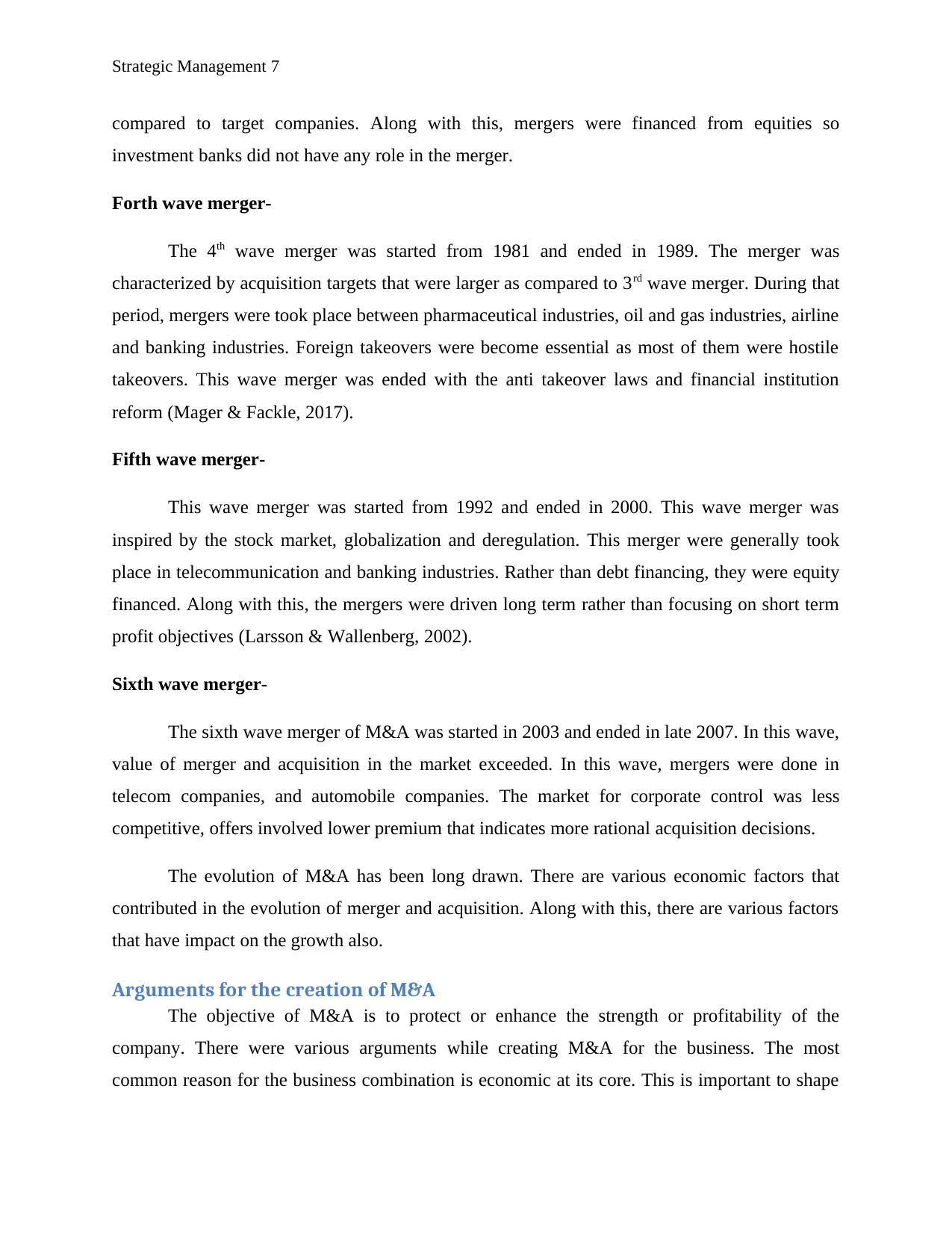
Strategic Management 7
compared to target companies. Along with this, mergers were financed from equities so
investment banks did not have any role in the merger.
Forth wave merger-
The 4th wave merger was started from 1981 and ended in 1989. The merger was
characterized by acquisition targets that were larger as compared to 3rd wave merger. During that
period, mergers were took place between pharmaceutical industries, oil and gas industries, airline
and banking industries. Foreign takeovers were become essential as most of them were hostile
takeovers. This wave merger was ended with the anti takeover laws and financial institution
reform (Mager & Fackle, 2017).
Fifth wave merger-
This wave merger was started from 1992 and ended in 2000. This wave merger was
inspired by the stock market, globalization and deregulation. This merger were generally took
place in telecommunication and banking industries. Rather than debt financing, they were equity
financed. Along with this, the mergers were driven long term rather than focusing on short term
profit objectives (Larsson & Wallenberg, 2002).
Sixth wave merger-
The sixth wave merger of M&A was started in 2003 and ended in late 2007. In this wave,
value of merger and acquisition in the market exceeded. In this wave, mergers were done in
telecom companies, and automobile companies. The market for corporate control was less
competitive, offers involved lower premium that indicates more rational acquisition decisions.
The evolution of M&A has been long drawn. There are various economic factors that
contributed in the evolution of merger and acquisition. Along with this, there are various factors
that have impact on the growth also.
Arguments for the creation of M&A
The objective of M&A is to protect or enhance the strength or profitability of the
company. There were various arguments while creating M&A for the business. The most
common reason for the business combination is economic at its core. This is important to shape
compared to target companies. Along with this, mergers were financed from equities so
investment banks did not have any role in the merger.
Forth wave merger-
The 4th wave merger was started from 1981 and ended in 1989. The merger was
characterized by acquisition targets that were larger as compared to 3rd wave merger. During that
period, mergers were took place between pharmaceutical industries, oil and gas industries, airline
and banking industries. Foreign takeovers were become essential as most of them were hostile
takeovers. This wave merger was ended with the anti takeover laws and financial institution
reform (Mager & Fackle, 2017).
Fifth wave merger-
This wave merger was started from 1992 and ended in 2000. This wave merger was
inspired by the stock market, globalization and deregulation. This merger were generally took
place in telecommunication and banking industries. Rather than debt financing, they were equity
financed. Along with this, the mergers were driven long term rather than focusing on short term
profit objectives (Larsson & Wallenberg, 2002).
Sixth wave merger-
The sixth wave merger of M&A was started in 2003 and ended in late 2007. In this wave,
value of merger and acquisition in the market exceeded. In this wave, mergers were done in
telecom companies, and automobile companies. The market for corporate control was less
competitive, offers involved lower premium that indicates more rational acquisition decisions.
The evolution of M&A has been long drawn. There are various economic factors that
contributed in the evolution of merger and acquisition. Along with this, there are various factors
that have impact on the growth also.
Arguments for the creation of M&A
The objective of M&A is to protect or enhance the strength or profitability of the
company. There were various arguments while creating M&A for the business. The most
common reason for the business combination is economic at its core. This is important to shape
Paraphrase This Document
Need a fresh take? Get an instant paraphrase of this document with our AI Paraphraser
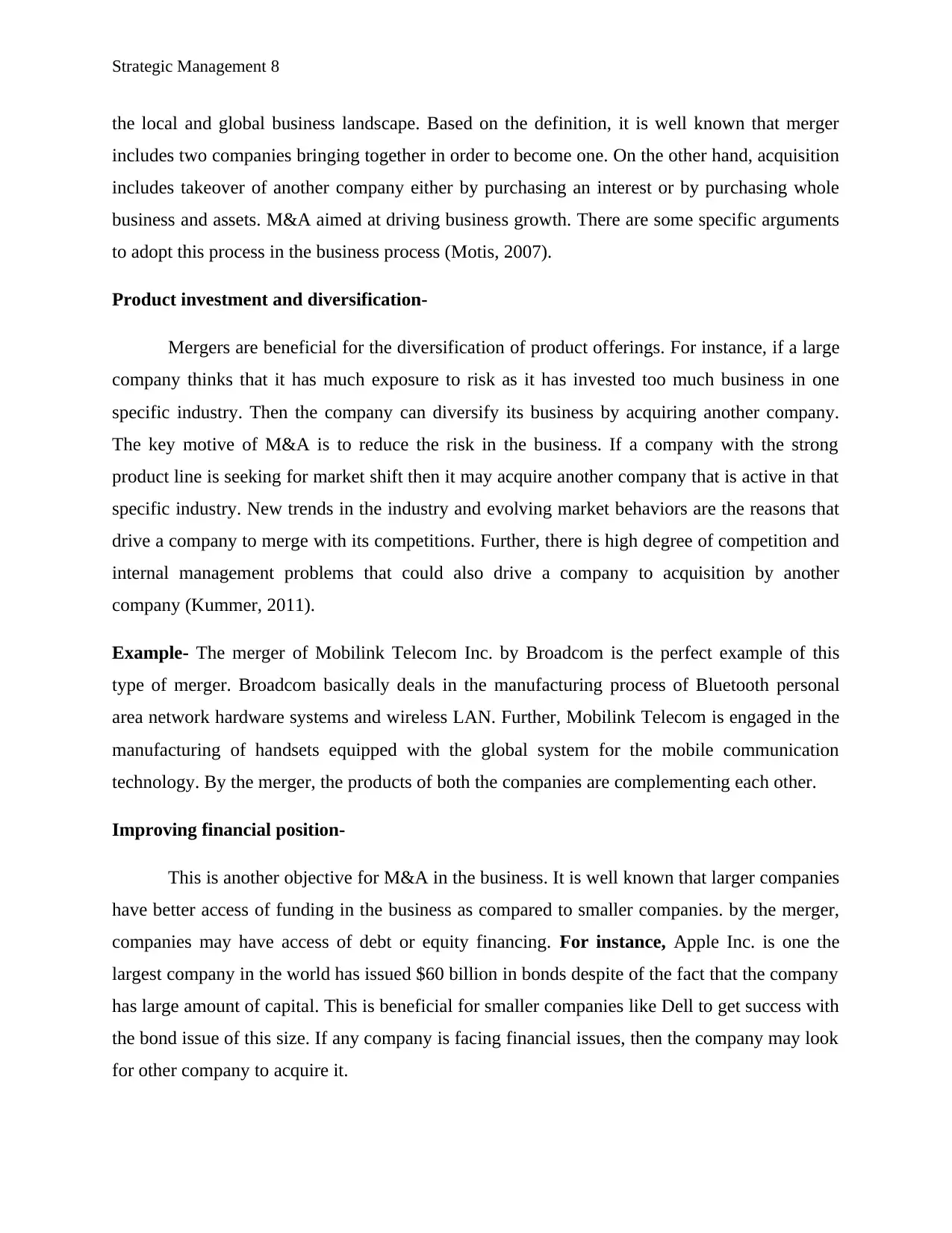
Strategic Management 8
the local and global business landscape. Based on the definition, it is well known that merger
includes two companies bringing together in order to become one. On the other hand, acquisition
includes takeover of another company either by purchasing an interest or by purchasing whole
business and assets. M&A aimed at driving business growth. There are some specific arguments
to adopt this process in the business process (Motis, 2007).
Product investment and diversification-
Mergers are beneficial for the diversification of product offerings. For instance, if a large
company thinks that it has much exposure to risk as it has invested too much business in one
specific industry. Then the company can diversify its business by acquiring another company.
The key motive of M&A is to reduce the risk in the business. If a company with the strong
product line is seeking for market shift then it may acquire another company that is active in that
specific industry. New trends in the industry and evolving market behaviors are the reasons that
drive a company to merge with its competitions. Further, there is high degree of competition and
internal management problems that could also drive a company to acquisition by another
company (Kummer, 2011).
Example- The merger of Mobilink Telecom Inc. by Broadcom is the perfect example of this
type of merger. Broadcom basically deals in the manufacturing process of Bluetooth personal
area network hardware systems and wireless LAN. Further, Mobilink Telecom is engaged in the
manufacturing of handsets equipped with the global system for the mobile communication
technology. By the merger, the products of both the companies are complementing each other.
Improving financial position-
This is another objective for M&A in the business. It is well known that larger companies
have better access of funding in the business as compared to smaller companies. by the merger,
companies may have access of debt or equity financing. For instance, Apple Inc. is one the
largest company in the world has issued $60 billion in bonds despite of the fact that the company
has large amount of capital. This is beneficial for smaller companies like Dell to get success with
the bond issue of this size. If any company is facing financial issues, then the company may look
for other company to acquire it.
the local and global business landscape. Based on the definition, it is well known that merger
includes two companies bringing together in order to become one. On the other hand, acquisition
includes takeover of another company either by purchasing an interest or by purchasing whole
business and assets. M&A aimed at driving business growth. There are some specific arguments
to adopt this process in the business process (Motis, 2007).
Product investment and diversification-
Mergers are beneficial for the diversification of product offerings. For instance, if a large
company thinks that it has much exposure to risk as it has invested too much business in one
specific industry. Then the company can diversify its business by acquiring another company.
The key motive of M&A is to reduce the risk in the business. If a company with the strong
product line is seeking for market shift then it may acquire another company that is active in that
specific industry. New trends in the industry and evolving market behaviors are the reasons that
drive a company to merge with its competitions. Further, there is high degree of competition and
internal management problems that could also drive a company to acquisition by another
company (Kummer, 2011).
Example- The merger of Mobilink Telecom Inc. by Broadcom is the perfect example of this
type of merger. Broadcom basically deals in the manufacturing process of Bluetooth personal
area network hardware systems and wireless LAN. Further, Mobilink Telecom is engaged in the
manufacturing of handsets equipped with the global system for the mobile communication
technology. By the merger, the products of both the companies are complementing each other.
Improving financial position-
This is another objective for M&A in the business. It is well known that larger companies
have better access of funding in the business as compared to smaller companies. by the merger,
companies may have access of debt or equity financing. For instance, Apple Inc. is one the
largest company in the world has issued $60 billion in bonds despite of the fact that the company
has large amount of capital. This is beneficial for smaller companies like Dell to get success with
the bond issue of this size. If any company is facing financial issues, then the company may look
for other company to acquire it.
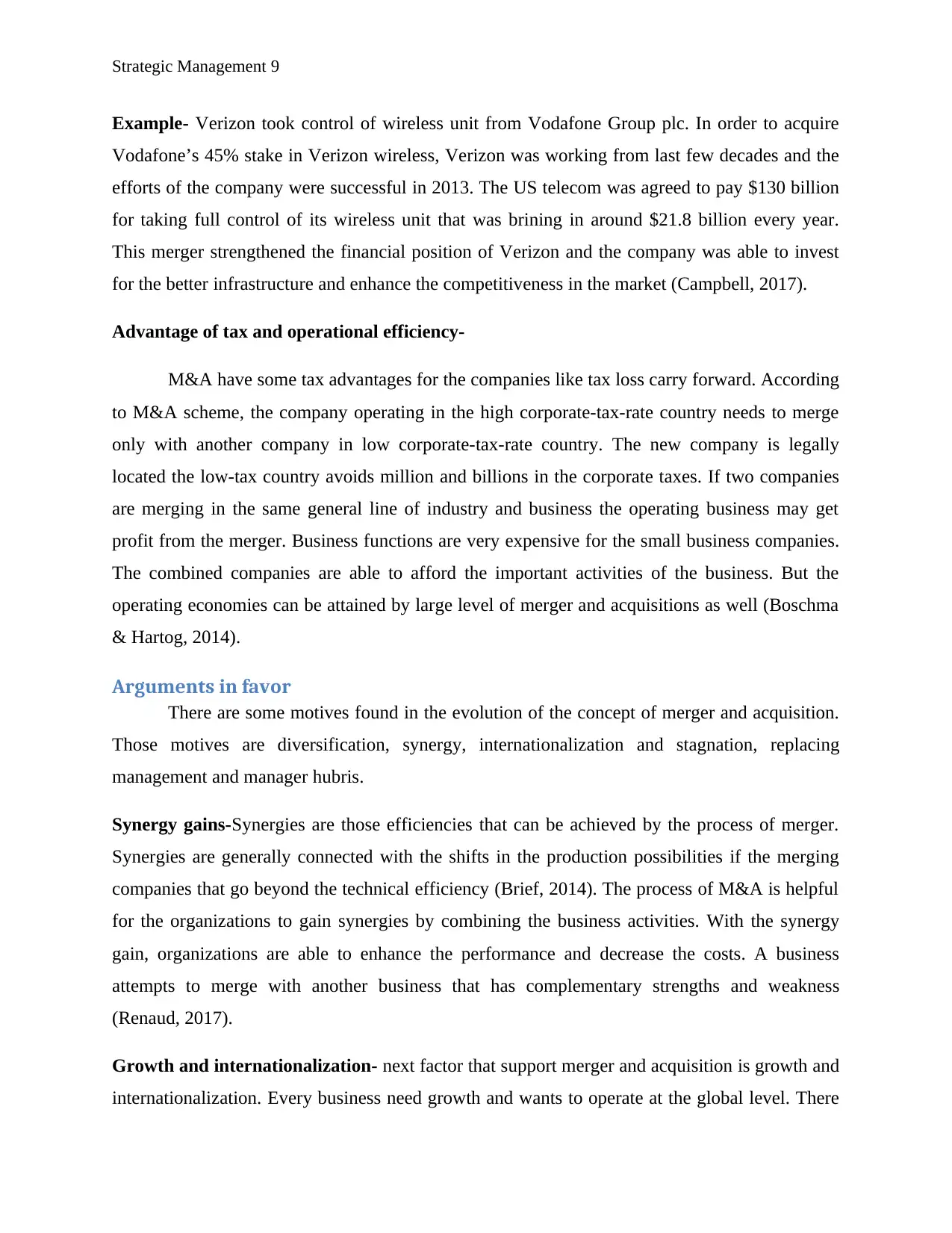
Strategic Management 9
Example- Verizon took control of wireless unit from Vodafone Group plc. In order to acquire
Vodafone’s 45% stake in Verizon wireless, Verizon was working from last few decades and the
efforts of the company were successful in 2013. The US telecom was agreed to pay $130 billion
for taking full control of its wireless unit that was brining in around $21.8 billion every year.
This merger strengthened the financial position of Verizon and the company was able to invest
for the better infrastructure and enhance the competitiveness in the market (Campbell, 2017).
Advantage of tax and operational efficiency-
M&A have some tax advantages for the companies like tax loss carry forward. According
to M&A scheme, the company operating in the high corporate-tax-rate country needs to merge
only with another company in low corporate-tax-rate country. The new company is legally
located the low-tax country avoids million and billions in the corporate taxes. If two companies
are merging in the same general line of industry and business the operating business may get
profit from the merger. Business functions are very expensive for the small business companies.
The combined companies are able to afford the important activities of the business. But the
operating economies can be attained by large level of merger and acquisitions as well (Boschma
& Hartog, 2014).
Arguments in favor
There are some motives found in the evolution of the concept of merger and acquisition.
Those motives are diversification, synergy, internationalization and stagnation, replacing
management and manager hubris.
Synergy gains-Synergies are those efficiencies that can be achieved by the process of merger.
Synergies are generally connected with the shifts in the production possibilities if the merging
companies that go beyond the technical efficiency (Brief, 2014). The process of M&A is helpful
for the organizations to gain synergies by combining the business activities. With the synergy
gain, organizations are able to enhance the performance and decrease the costs. A business
attempts to merge with another business that has complementary strengths and weakness
(Renaud, 2017).
Growth and internationalization- next factor that support merger and acquisition is growth and
internationalization. Every business need growth and wants to operate at the global level. There
Example- Verizon took control of wireless unit from Vodafone Group plc. In order to acquire
Vodafone’s 45% stake in Verizon wireless, Verizon was working from last few decades and the
efforts of the company were successful in 2013. The US telecom was agreed to pay $130 billion
for taking full control of its wireless unit that was brining in around $21.8 billion every year.
This merger strengthened the financial position of Verizon and the company was able to invest
for the better infrastructure and enhance the competitiveness in the market (Campbell, 2017).
Advantage of tax and operational efficiency-
M&A have some tax advantages for the companies like tax loss carry forward. According
to M&A scheme, the company operating in the high corporate-tax-rate country needs to merge
only with another company in low corporate-tax-rate country. The new company is legally
located the low-tax country avoids million and billions in the corporate taxes. If two companies
are merging in the same general line of industry and business the operating business may get
profit from the merger. Business functions are very expensive for the small business companies.
The combined companies are able to afford the important activities of the business. But the
operating economies can be attained by large level of merger and acquisitions as well (Boschma
& Hartog, 2014).
Arguments in favor
There are some motives found in the evolution of the concept of merger and acquisition.
Those motives are diversification, synergy, internationalization and stagnation, replacing
management and manager hubris.
Synergy gains-Synergies are those efficiencies that can be achieved by the process of merger.
Synergies are generally connected with the shifts in the production possibilities if the merging
companies that go beyond the technical efficiency (Brief, 2014). The process of M&A is helpful
for the organizations to gain synergies by combining the business activities. With the synergy
gain, organizations are able to enhance the performance and decrease the costs. A business
attempts to merge with another business that has complementary strengths and weakness
(Renaud, 2017).
Growth and internationalization- next factor that support merger and acquisition is growth and
internationalization. Every business need growth and wants to operate at the global level. There
⊘ This is a preview!⊘
Do you want full access?
Subscribe today to unlock all pages.

Trusted by 1+ million students worldwide
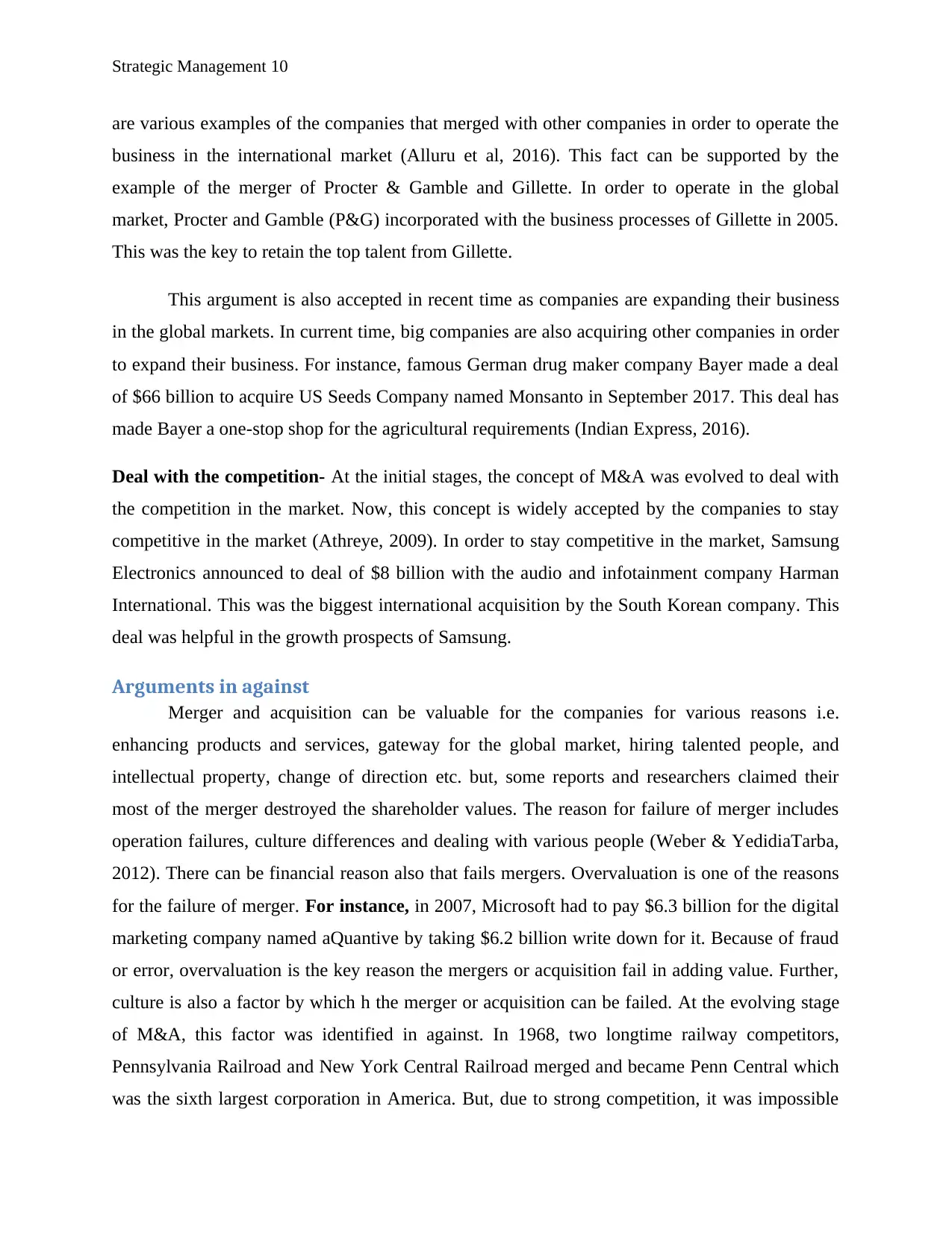
Strategic Management 10
are various examples of the companies that merged with other companies in order to operate the
business in the international market (Alluru et al, 2016). This fact can be supported by the
example of the merger of Procter & Gamble and Gillette. In order to operate in the global
market, Procter and Gamble (P&G) incorporated with the business processes of Gillette in 2005.
This was the key to retain the top talent from Gillette.
This argument is also accepted in recent time as companies are expanding their business
in the global markets. In current time, big companies are also acquiring other companies in order
to expand their business. For instance, famous German drug maker company Bayer made a deal
of $66 billion to acquire US Seeds Company named Monsanto in September 2017. This deal has
made Bayer a one-stop shop for the agricultural requirements (Indian Express, 2016).
Deal with the competition- At the initial stages, the concept of M&A was evolved to deal with
the competition in the market. Now, this concept is widely accepted by the companies to stay
competitive in the market (Athreye, 2009). In order to stay competitive in the market, Samsung
Electronics announced to deal of $8 billion with the audio and infotainment company Harman
International. This was the biggest international acquisition by the South Korean company. This
deal was helpful in the growth prospects of Samsung.
Arguments in against
Merger and acquisition can be valuable for the companies for various reasons i.e.
enhancing products and services, gateway for the global market, hiring talented people, and
intellectual property, change of direction etc. but, some reports and researchers claimed their
most of the merger destroyed the shareholder values. The reason for failure of merger includes
operation failures, culture differences and dealing with various people (Weber & YedidiaTarba,
2012). There can be financial reason also that fails mergers. Overvaluation is one of the reasons
for the failure of merger. For instance, in 2007, Microsoft had to pay $6.3 billion for the digital
marketing company named aQuantive by taking $6.2 billion write down for it. Because of fraud
or error, overvaluation is the key reason the mergers or acquisition fail in adding value. Further,
culture is also a factor by which h the merger or acquisition can be failed. At the evolving stage
of M&A, this factor was identified in against. In 1968, two longtime railway competitors,
Pennsylvania Railroad and New York Central Railroad merged and became Penn Central which
was the sixth largest corporation in America. But, due to strong competition, it was impossible
are various examples of the companies that merged with other companies in order to operate the
business in the international market (Alluru et al, 2016). This fact can be supported by the
example of the merger of Procter & Gamble and Gillette. In order to operate in the global
market, Procter and Gamble (P&G) incorporated with the business processes of Gillette in 2005.
This was the key to retain the top talent from Gillette.
This argument is also accepted in recent time as companies are expanding their business
in the global markets. In current time, big companies are also acquiring other companies in order
to expand their business. For instance, famous German drug maker company Bayer made a deal
of $66 billion to acquire US Seeds Company named Monsanto in September 2017. This deal has
made Bayer a one-stop shop for the agricultural requirements (Indian Express, 2016).
Deal with the competition- At the initial stages, the concept of M&A was evolved to deal with
the competition in the market. Now, this concept is widely accepted by the companies to stay
competitive in the market (Athreye, 2009). In order to stay competitive in the market, Samsung
Electronics announced to deal of $8 billion with the audio and infotainment company Harman
International. This was the biggest international acquisition by the South Korean company. This
deal was helpful in the growth prospects of Samsung.
Arguments in against
Merger and acquisition can be valuable for the companies for various reasons i.e.
enhancing products and services, gateway for the global market, hiring talented people, and
intellectual property, change of direction etc. but, some reports and researchers claimed their
most of the merger destroyed the shareholder values. The reason for failure of merger includes
operation failures, culture differences and dealing with various people (Weber & YedidiaTarba,
2012). There can be financial reason also that fails mergers. Overvaluation is one of the reasons
for the failure of merger. For instance, in 2007, Microsoft had to pay $6.3 billion for the digital
marketing company named aQuantive by taking $6.2 billion write down for it. Because of fraud
or error, overvaluation is the key reason the mergers or acquisition fail in adding value. Further,
culture is also a factor by which h the merger or acquisition can be failed. At the evolving stage
of M&A, this factor was identified in against. In 1968, two longtime railway competitors,
Pennsylvania Railroad and New York Central Railroad merged and became Penn Central which
was the sixth largest corporation in America. But, due to strong competition, it was impossible
Paraphrase This Document
Need a fresh take? Get an instant paraphrase of this document with our AI Paraphraser
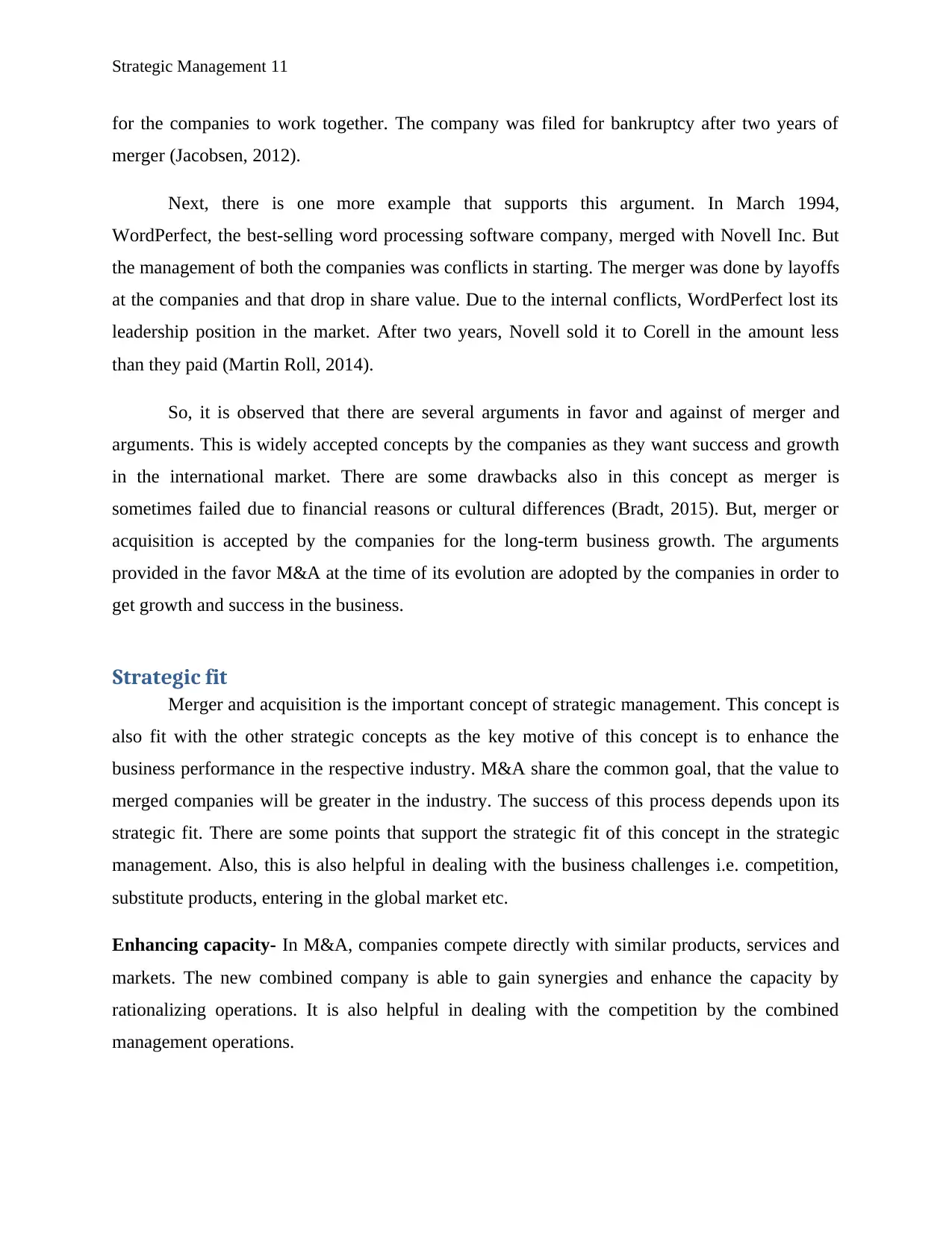
Strategic Management 11
for the companies to work together. The company was filed for bankruptcy after two years of
merger (Jacobsen, 2012).
Next, there is one more example that supports this argument. In March 1994,
WordPerfect, the best-selling word processing software company, merged with Novell Inc. But
the management of both the companies was conflicts in starting. The merger was done by layoffs
at the companies and that drop in share value. Due to the internal conflicts, WordPerfect lost its
leadership position in the market. After two years, Novell sold it to Corell in the amount less
than they paid (Martin Roll, 2014).
So, it is observed that there are several arguments in favor and against of merger and
arguments. This is widely accepted concepts by the companies as they want success and growth
in the international market. There are some drawbacks also in this concept as merger is
sometimes failed due to financial reasons or cultural differences (Bradt, 2015). But, merger or
acquisition is accepted by the companies for the long-term business growth. The arguments
provided in the favor M&A at the time of its evolution are adopted by the companies in order to
get growth and success in the business.
Strategic fit
Merger and acquisition is the important concept of strategic management. This concept is
also fit with the other strategic concepts as the key motive of this concept is to enhance the
business performance in the respective industry. M&A share the common goal, that the value to
merged companies will be greater in the industry. The success of this process depends upon its
strategic fit. There are some points that support the strategic fit of this concept in the strategic
management. Also, this is also helpful in dealing with the business challenges i.e. competition,
substitute products, entering in the global market etc.
Enhancing capacity- In M&A, companies compete directly with similar products, services and
markets. The new combined company is able to gain synergies and enhance the capacity by
rationalizing operations. It is also helpful in dealing with the competition by the combined
management operations.
for the companies to work together. The company was filed for bankruptcy after two years of
merger (Jacobsen, 2012).
Next, there is one more example that supports this argument. In March 1994,
WordPerfect, the best-selling word processing software company, merged with Novell Inc. But
the management of both the companies was conflicts in starting. The merger was done by layoffs
at the companies and that drop in share value. Due to the internal conflicts, WordPerfect lost its
leadership position in the market. After two years, Novell sold it to Corell in the amount less
than they paid (Martin Roll, 2014).
So, it is observed that there are several arguments in favor and against of merger and
arguments. This is widely accepted concepts by the companies as they want success and growth
in the international market. There are some drawbacks also in this concept as merger is
sometimes failed due to financial reasons or cultural differences (Bradt, 2015). But, merger or
acquisition is accepted by the companies for the long-term business growth. The arguments
provided in the favor M&A at the time of its evolution are adopted by the companies in order to
get growth and success in the business.
Strategic fit
Merger and acquisition is the important concept of strategic management. This concept is
also fit with the other strategic concepts as the key motive of this concept is to enhance the
business performance in the respective industry. M&A share the common goal, that the value to
merged companies will be greater in the industry. The success of this process depends upon its
strategic fit. There are some points that support the strategic fit of this concept in the strategic
management. Also, this is also helpful in dealing with the business challenges i.e. competition,
substitute products, entering in the global market etc.
Enhancing capacity- In M&A, companies compete directly with similar products, services and
markets. The new combined company is able to gain synergies and enhance the capacity by
rationalizing operations. It is also helpful in dealing with the competition by the combined
management operations.
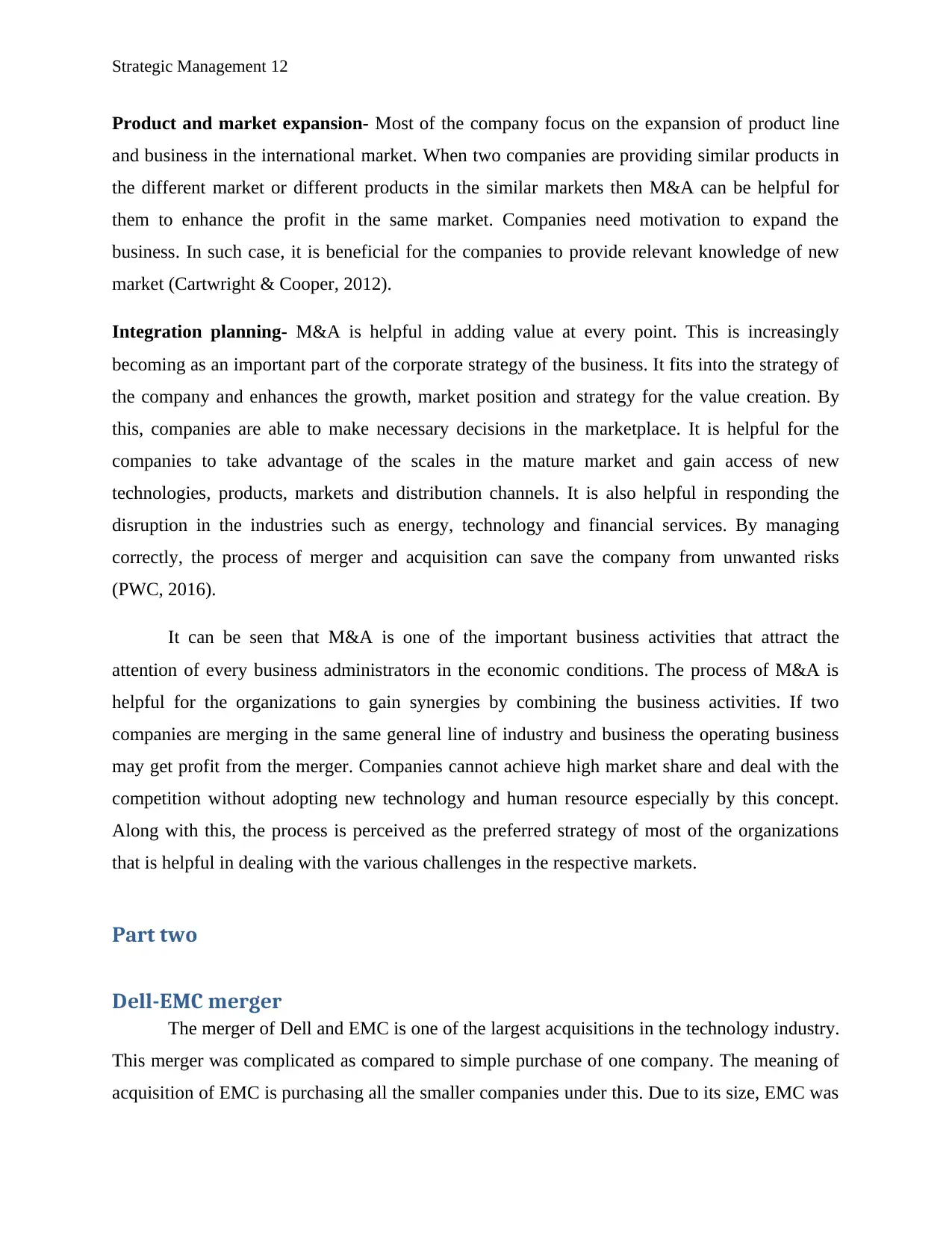
Strategic Management 12
Product and market expansion- Most of the company focus on the expansion of product line
and business in the international market. When two companies are providing similar products in
the different market or different products in the similar markets then M&A can be helpful for
them to enhance the profit in the same market. Companies need motivation to expand the
business. In such case, it is beneficial for the companies to provide relevant knowledge of new
market (Cartwright & Cooper, 2012).
Integration planning- M&A is helpful in adding value at every point. This is increasingly
becoming as an important part of the corporate strategy of the business. It fits into the strategy of
the company and enhances the growth, market position and strategy for the value creation. By
this, companies are able to make necessary decisions in the marketplace. It is helpful for the
companies to take advantage of the scales in the mature market and gain access of new
technologies, products, markets and distribution channels. It is also helpful in responding the
disruption in the industries such as energy, technology and financial services. By managing
correctly, the process of merger and acquisition can save the company from unwanted risks
(PWC, 2016).
It can be seen that M&A is one of the important business activities that attract the
attention of every business administrators in the economic conditions. The process of M&A is
helpful for the organizations to gain synergies by combining the business activities. If two
companies are merging in the same general line of industry and business the operating business
may get profit from the merger. Companies cannot achieve high market share and deal with the
competition without adopting new technology and human resource especially by this concept.
Along with this, the process is perceived as the preferred strategy of most of the organizations
that is helpful in dealing with the various challenges in the respective markets.
Part two
Dell-EMC merger
The merger of Dell and EMC is one of the largest acquisitions in the technology industry.
This merger was complicated as compared to simple purchase of one company. The meaning of
acquisition of EMC is purchasing all the smaller companies under this. Due to its size, EMC was
Product and market expansion- Most of the company focus on the expansion of product line
and business in the international market. When two companies are providing similar products in
the different market or different products in the similar markets then M&A can be helpful for
them to enhance the profit in the same market. Companies need motivation to expand the
business. In such case, it is beneficial for the companies to provide relevant knowledge of new
market (Cartwright & Cooper, 2012).
Integration planning- M&A is helpful in adding value at every point. This is increasingly
becoming as an important part of the corporate strategy of the business. It fits into the strategy of
the company and enhances the growth, market position and strategy for the value creation. By
this, companies are able to make necessary decisions in the marketplace. It is helpful for the
companies to take advantage of the scales in the mature market and gain access of new
technologies, products, markets and distribution channels. It is also helpful in responding the
disruption in the industries such as energy, technology and financial services. By managing
correctly, the process of merger and acquisition can save the company from unwanted risks
(PWC, 2016).
It can be seen that M&A is one of the important business activities that attract the
attention of every business administrators in the economic conditions. The process of M&A is
helpful for the organizations to gain synergies by combining the business activities. If two
companies are merging in the same general line of industry and business the operating business
may get profit from the merger. Companies cannot achieve high market share and deal with the
competition without adopting new technology and human resource especially by this concept.
Along with this, the process is perceived as the preferred strategy of most of the organizations
that is helpful in dealing with the various challenges in the respective markets.
Part two
Dell-EMC merger
The merger of Dell and EMC is one of the largest acquisitions in the technology industry.
This merger was complicated as compared to simple purchase of one company. The meaning of
acquisition of EMC is purchasing all the smaller companies under this. Due to its size, EMC was
⊘ This is a preview!⊘
Do you want full access?
Subscribe today to unlock all pages.

Trusted by 1+ million students worldwide
1 out of 20
Related Documents
Your All-in-One AI-Powered Toolkit for Academic Success.
+13062052269
info@desklib.com
Available 24*7 on WhatsApp / Email
![[object Object]](/_next/static/media/star-bottom.7253800d.svg)
Unlock your academic potential
Copyright © 2020–2025 A2Z Services. All Rights Reserved. Developed and managed by ZUCOL.




